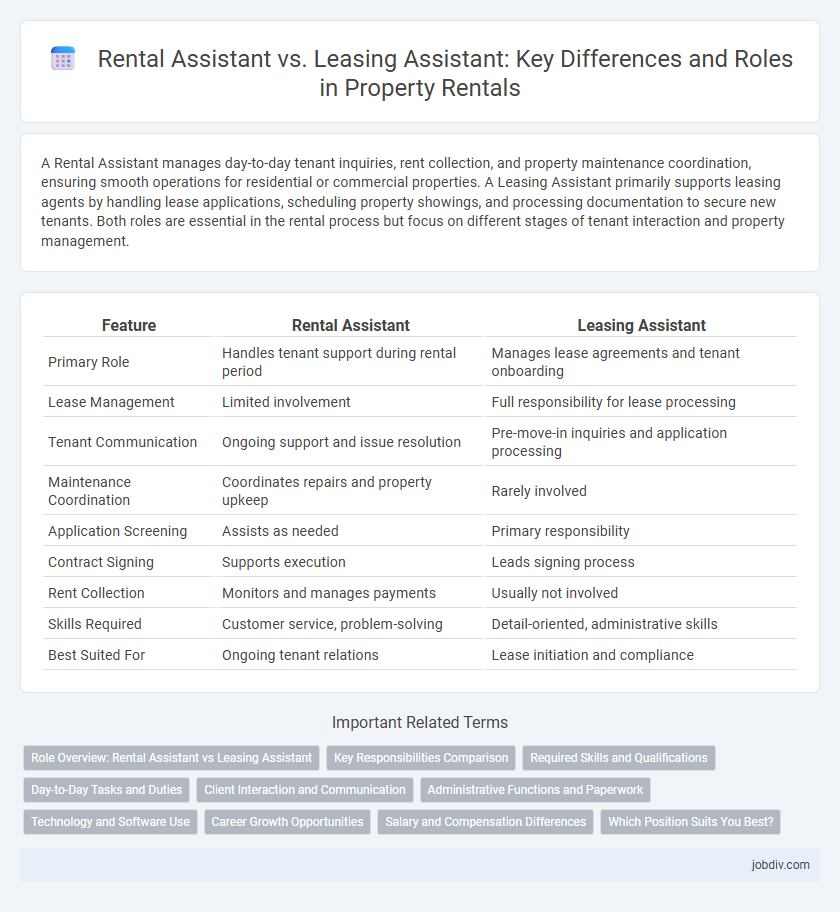A Rental Assistant manages day-to-day tenant inquiries, rent collection, and property maintenance coordination, ensuring smooth operations for residential or commercial properties. A Leasing Assistant primarily supports leasing agents by handling lease applications, scheduling property showings, and processing documentation to secure new tenants. Both roles are essential in the rental process but focus on different stages of tenant interaction and property management.
Table of Comparison
| Feature | Rental Assistant | Leasing Assistant |
|---|---|---|
| Primary Role | Handles tenant support during rental period | Manages lease agreements and tenant onboarding |
| Lease Management | Limited involvement | Full responsibility for lease processing |
| Tenant Communication | Ongoing support and issue resolution | Pre-move-in inquiries and application processing |
| Maintenance Coordination | Coordinates repairs and property upkeep | Rarely involved |
| Application Screening | Assists as needed | Primary responsibility |
| Contract Signing | Supports execution | Leads signing process |
| Rent Collection | Monitors and manages payments | Usually not involved |
| Skills Required | Customer service, problem-solving | Detail-oriented, administrative skills |
| Best Suited For | Ongoing tenant relations | Lease initiation and compliance |
Role Overview: Rental Assistant vs Leasing Assistant
A Rental Assistant primarily supports daily rental operations, handling tenant inquiries, processing rental applications, and coordinating maintenance requests to ensure smooth property management. A Leasing Assistant focuses on marketing rental properties, scheduling showings, preparing lease agreements, and facilitating tenant move-ins and move-outs. Both roles contribute to tenant satisfaction but differ in scope, with Rental Assistants emphasizing operational support and Leasing Assistants targeting lease facilitation and property promotion.
Key Responsibilities Comparison
A Rental Assistant primarily manages tenant inquiries, processes rental applications, and coordinates move-ins and move-outs, focusing on day-to-day rental operations and customer service. A Leasing Assistant supports leasing agents by preparing lease agreements, conducting property tours, and assisting with marketing efforts, emphasizing lease negotiations and tenant acquisition. Both roles require strong communication skills but differ in their focus on administrative support versus direct tenant interaction and lease management.
Required Skills and Qualifications
Rental Assistants specialize in customer service, property showing, and lease application processing, requiring strong communication and organizational skills. Leasing Assistants focus more on administrative support, legal documentation, and lease agreement preparation, demanding attention to detail, knowledge of property management software, and familiarity with landlord-tenant laws. Both roles typically require experience in real estate or property management, proficiency in multitasking, and an understanding of rental market trends.
Day-to-Day Tasks and Duties
Rental Assistants handle daily interactions with tenants, processing rental applications, collecting payments, and addressing maintenance requests to ensure tenant satisfaction. Leasing Assistants focus more on marketing vacancies, conducting property tours, preparing lease agreements, and coordinating move-in processes to support lease acquisitions. Both roles collaborate closely but differ primarily in tenant management and lease facilitation responsibilities.
Client Interaction and Communication
Rental Assistants primarily handle initial inquiries and facilitate seamless communication throughout the rental process, ensuring clients receive timely information about available properties and application status. Leasing Assistants focus on detailed contract discussions, lease negotiations, and addressing specific client concerns to secure lease agreements efficiently. Both roles prioritize effective client interaction, with Rental Assistants emphasizing front-end communication and Leasing Assistants managing in-depth lease-related dialogues.
Administrative Functions and Paperwork
A Rental Assistant primarily manages tenant applications, verifies rental qualifications, and processes lease agreements, ensuring accurate documentation and compliance with rental policies. Leasing Assistants handle broader administrative functions like coordinating property showings, preparing leasing documents, and tracking lease renewals to support the leasing agent's workflow. Both roles require meticulous attention to paperwork, but Leasing Assistants often engage in more dynamic client interactions alongside administrative tasks.
Technology and Software Use
Rental Assistants primarily utilize property management software and CRM platforms to streamline tenant communication, track rental payments, and schedule maintenance requests. Leasing Assistants often leverage advanced leasing software equipped with digital application processing, electronic signatures, and automated lease generation to expedite tenant onboarding. Both roles increasingly depend on integrated technology solutions to enhance operational efficiency and improve tenant satisfaction.
Career Growth Opportunities
Rental Assistants typically gain hands-on experience with tenant interactions, property maintenance coordination, and rental application processing, providing a solid foundation for advancing into Property Manager roles. Leasing Assistants often develop specialized skills in marketing rental units, negotiating lease terms, and conducting credit checks, which can lead to careers in Leasing Management or Real Estate Sales. Both roles offer pathways to higher positions within property management, but Leasing Assistants may have more direct exposure to sales and client acquisition strategies critical for career growth in real estate.
Salary and Compensation Differences
Rental Assistants typically earn an hourly wage ranging from $12 to $18, while Leasing Assistants often secure higher salaries between $30,000 and $45,000 annually due to added responsibilities such as lease negotiations. Compensation for Leasing Assistants frequently includes bonuses or commissions tied to successful lease signings, enhancing overall earnings. Benefits like health insurance and paid time off are more commonly offered to Leasing Assistants than Rental Assistants, reflecting the role's elevated status in property management.
Which Position Suits You Best?
A Rental Assistant primarily manages tenant communications, processes rental applications, and schedules property showings, making it ideal for those who enjoy direct client interaction and administrative tasks. In contrast, a Leasing Assistant supports property managers with lease preparations, contract management, and compliance, suited for individuals with strong organizational skills and attention to legal detail. Choosing the right role depends on your preference for customer service versus administrative and regulatory responsibilities in the rental property sector.
Rental Assistant vs Leasing Assistant Infographic

 jobdiv.com
jobdiv.com